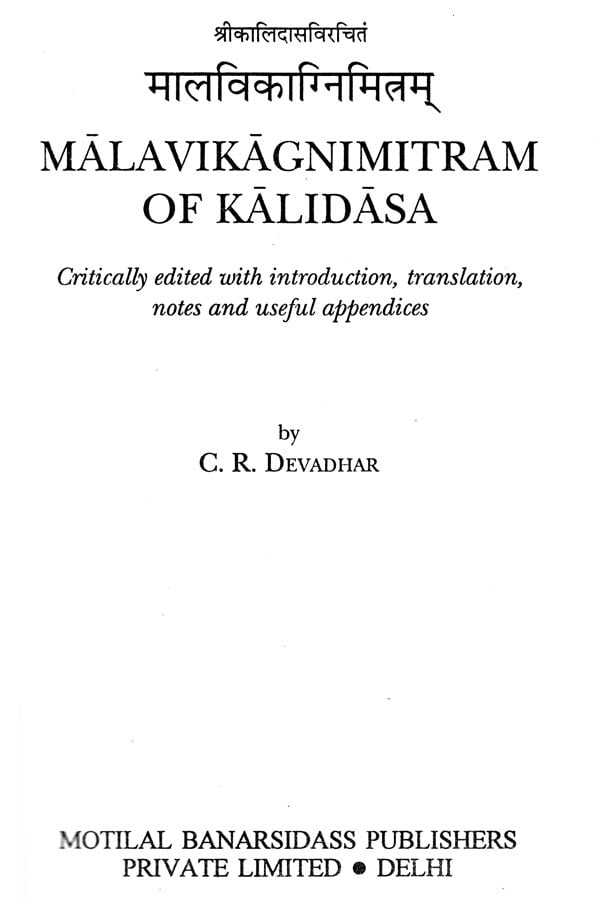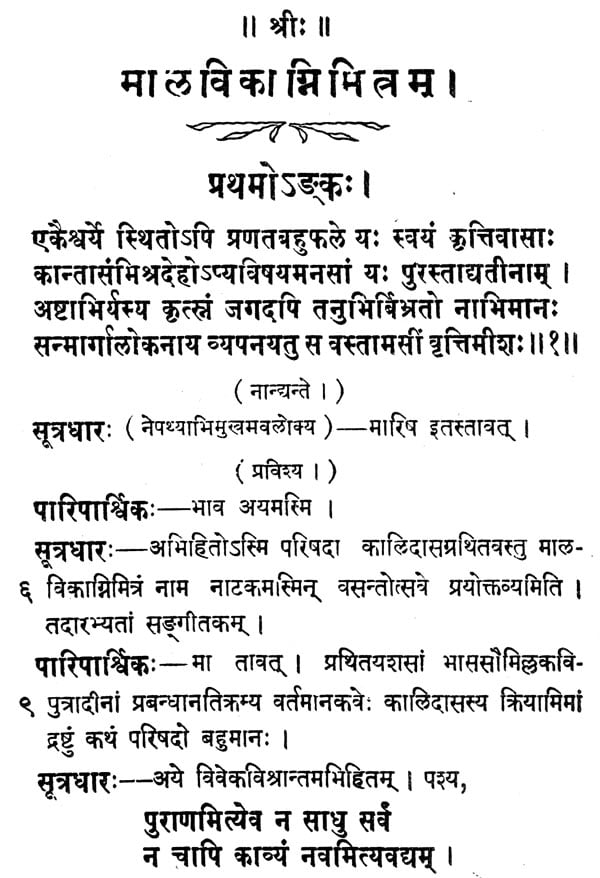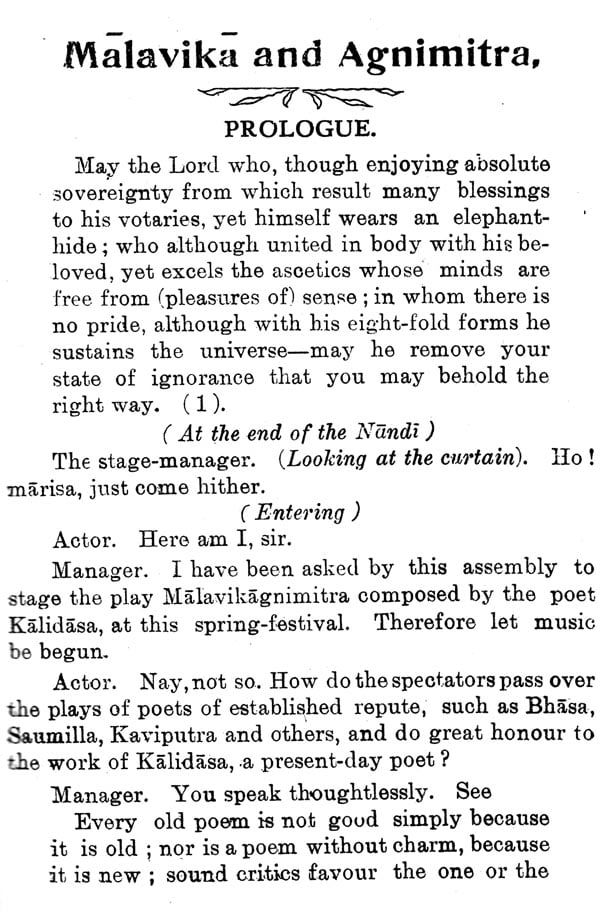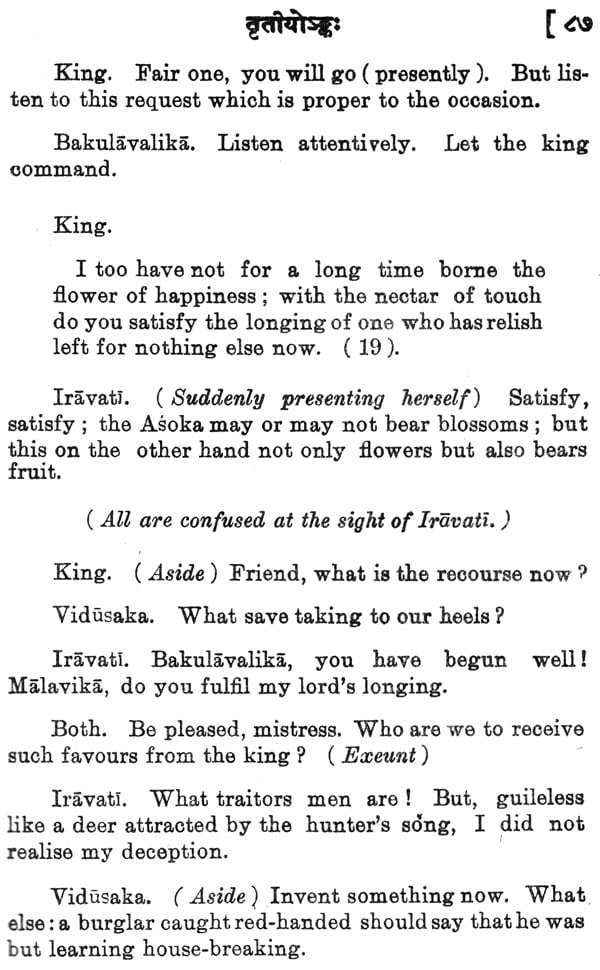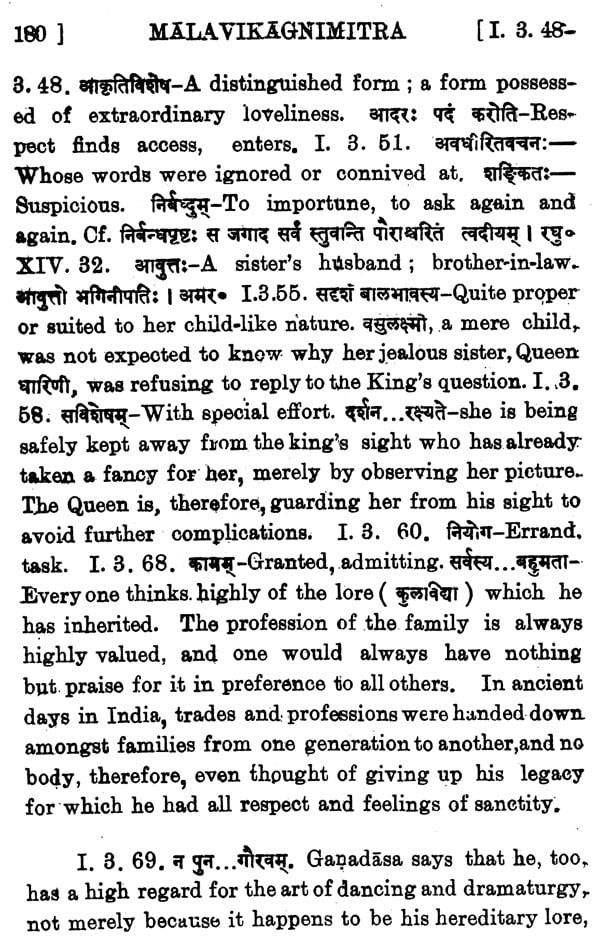
Malavikagnimitram of Kalidasa
Book Specification
| Item Code: | NAT655 |
| Author: | C.R. Devadhar |
| Publisher: | MOTILAL BANARSIDASS PUBLISHERS PVT. LTD. |
| Language: | SANSKRIT TEXT WITH ENGLISH TR |
| Edition: | 2018 |
| ISBN: | 9788120802216 |
| Pages: | 312 |
| Cover: | PAPERBACK |
| Other Details | 7.00 X 5.00 inch |
| Weight | 210 gm |
Book Description
It will be readily admitted that in spite of the many critical editions of the plays of Kalidasa, editions of the plays on the lines of the up-to-date editions of the classics in the West have not so far been published. This edition is, to our knowledge, the first which is infinitely more useful and handy than either having the translation on the same page just below the text, or at the end of the text. Further it has been our endeavour to make the work as critical and useful for the students as possible, without either encumbering it with tiresome discussions of technical and scholastic points, or skipping over difficult and necessary details about Variae Lectiones or rhetorical or grammatical points. Special care has been taken to give a correct orthography of the Prakrit words, after a careful and critical comparison of the various editions of the play before us.
In preparing this edition, we have fully availed our- selves of the already numerous published editions of the play and critical articles and books on the subject; and we gratefully make our acknowledgements to them. We are very thankful to our publishers for their readiness in undertaking to bring out this edition.
What De Quincy says of Shakespeare meets the case of Kalidasa far more appropriately than that of the English poet. "That he lived and that he died and that he was alittle lower than the angels," this pretty nearly makes up the amount of vur undisputed report of the great poet. Tradition has given us numerous legends, but they are no more than a mere farrago of absurd anachronisms. Modern research has done a good deal indeed to lift the veil from India’s past, and yet an exact and authentic account of the author is yet to be given. Of the numerous theories advanced by scholars regarding his age, only two seem now to have the support of indefeasible evidence both internal and external. There is the strong testimony of the quotations in the Mahabhasya of Patafijali which goes to prove that Sanskrit cour! epic dated from. before the time of the Christian Era, and the seme is now’amply corroborated by the recent epigraphic researches of modern scholars. This lends feasibility to the traditional legend of a king Vikrama the founder of the Samvat Era—5?7 B. OC. who kad at his court a circle of nine gems including Ké&li- disa, Varahamihira and Ghatakarpara.
It is on the other band contended that a comparison of the inscriptions which are mostly panegyrics of kings and which employ the Gupta Era which was first used by Candragupta Vikramaditya II, with the classical poems proves that the poetical style of the inscriptions prevailing in the fourth and fifth centuries did not much differ from the style of the Kavyas; and on the strength of this and simular epigraphic evidence it has been sought to prove that Kalidasa must have flourished under Candragupta II who assumed the title of Vikramaditya and succeeded his father Sam udragapte in 375 A. D. and made Ujjain his capital. Vincent Smith in his early history of India (p. 804, footnote) ex- presses the view that the earlier works of Kalidasa were composed before 418 A. D. during the regime of Can- dragupta, and his later works were written under Ku- maragupta I:(413 A. D. to 455 A. D.) and that possibly his literary career extended even into the reign of Ska- ndagupta ( 455 A. D. 480 A. D. ).
This is the sum of our knowledge of the external details of the poet’s life: and yet it may be asked: Are the few broad bare facts of life the only thing one should prize? Is not the poet known to usin the far richer world of his imaginative creations ? He neigh- bours us on every side, rouses our intellect, moves our passions, and stimulates our activity. It is well said, "The magnitude of life is not as to its external displace- ments but as to its subjective experiences. "
The impression that one gathers of the poet from his works is that of a man, deeply learned in literature and philosophy and other traditional lore of the times, and more deeply learned in the book of natare. A charming trait of hig personality is his modesty which Coleridge recognises as a sure sign of great genius.
He was & widely-travelled man and was a keen observer of nature. Not only did:the sublime and wild aspects of nature stir his imagination, but the milder and minute manifestations also caught his fanoy, and he is very fond of describing to us how the garden-plants bend to catch: the beauty of spring, or how the march of seasons affects them. But above all he isa student of the human hear: and is rarely excelled in his "delicate appreciation of its most refined and tender emotions and his familiarity with the workings and counter-workings of its conflict- ing feelings." Particularly he excels in depicting love "from the first suggestion in an innocent mind to the perfection of passion." All the three plays sing of love happy at the last and ‘ havened after tempest.’
Of his three plays, Malavikagnimitra was the earliest written and Sékuntala came last, while the Vikramorva- siya belongs to his middle period. We have merely to compare the prologues of the three plays to be convinc- ed of this; for in our play the author deems it necessary to explain away what would seem presumption ina contemporary poet to have offered his play for exhibi- tion before the elite to the exclusion of the plays of re- nowned writers. There is no such diffidence in the next two plays; moreover it will be observed from a com- parison of the three plays that "his ethical outlook on life was becoming progressively deeper and more spiri- tual" And lastly in spite of the frequent curiosa feli- citas of his diction, we do not come across that smooth- mess and rounded perfection and inevitable grace that mark the mature style of the poet.
